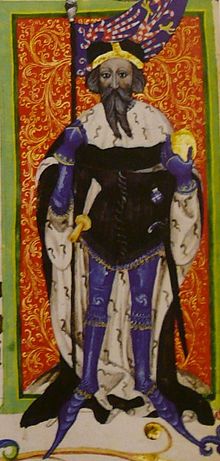Royal cloak (clothing)

A royal cloak is a representative, mostly sleeveless piece of clothing worn by kings , tribal princes and chiefs .
In many cultures, the head bears a tribe, a clan, a people as a symbol of domination and supreme jurisdiction, a special robe, a robe .
history
Images of the king wearing a crimson red stole, which is edged with gold as a symbol of power and wealth, and set with precious stones have come down to us from Assyria .
In the Old Testament , the king of Nineveh (8th century BC) wears a royal cloak ( Jonah 3,6 EU ). In the New Testament soldiers put a royal cloak (= "purple" ) on Jesus after his condemnation ( Mk 15.17 EU ).
Indian peoples used a cloak made of mostly colorful bird feathers or a bear skin or otter skin (chiefs of the Sauk and Fox ) or a specially colored woolen cloak as a sign of rulership . Many of these garments are still worn today at festivals.
The Ashanti in Ghana and the Ewe (people) in Ghana and Togo know the Kente , which is reserved for the locals. Strangers are not allowed to wear it; that would be sacrilege . Some designs were previously reserved for kings. The Kent cloth is usually worn in the form of a large patterned cloth, which is wrapped around the body like the toga of the Roman senators ; one end is knocked over the arm.
In Europe, the rulers usually wore the classic, wide-cut royal cloak made of velvet in purple . The dye was expensive and had to be imported (see also purple snail ). Since the late Middle Ages, the king's cloak was often lined or trimmed with ermine fur .
As "emperors", the Russian tsars wrapped themselves in a brocade robe in the style of Byzantine rulers. These garments, too, were lined or hemmed with ermine; the ermine is a symbol of the moral integrity and honesty of its wearer.
Representation in art
There are also depictions of the king's cloak in religious art. For example, in the parish church of St. Cross St. Wilgefortis in Neufahrn near Freising there is a Romanesque crucifix that was created around 1100. Christ there wears a royal cloak. Mary , the mother of Jesus, is called the Queen of Heaven . Her robes are blue (the color of the sky) or red (the color of love and passion).
The motif of the king's cloak also appears in legends . The spirit of the snow mountains in Austria wears a royal cloak made of gold and silver. Another legend deals with Lauenstein Castle in the Franconian Forest , which the Frankish King Konrad built in 915 as a bulwark against the Sorbs and Wends : A hermit advised Konrad, whom evil forces kept preventing the castle from building, to tear his royal cloak into pieces and a rope to tie in with it. Konrad put this rope around the top of a mountain. Now the castle was built. That is why the castle is popularly known as "Mantelburg" .
See also
Web links
literature
- Liselotte Andersen: Baroque and Rococo (= Encyclopedia of World Art. 12). Approved, unabridged paperback edition. Heyne, Munich 1980, ISBN 3-453-44048-X .
- Günther Drosdowski (Ed.): Duden . The large dictionary of the German language. Volume 4: Kam - N. Bibliographisches Institut, Mannheim et al. 1978, ISBN 3-411-01358-3 .
- Lars Elgklou: The Russia of the Tsars. Bechtermünz, Augsburg 1999, ISBN 3-8289-0319-3 .
- Herbert Haag , Dorothe Sölle, Caroline E. Ebertshäuser: Maria. The Mother of God in Faith, Customs and Art. Special edition. Herder, Freiburg im Breisgau et al. 2004, ISBN 3-451-28417-0 .
- Gerd Heinz-Mohr : Lexicon of symbols. Images and symbols of Christian art (= Diederichs yellow row. 150, Christianity ). New edition. Diederichs, Munich 1998, ISBN 3-424-01420-6 .
- Werner Petermann: The large picture atlas of Indians. The indigenous people of North America. History, cultures, peoples and tribes. Weltbild, Augsburg 2004, ISBN 3-8289-0747-4 .
- Auguste Racinet : World History of Costumes. Parkland, Cologne 1995, ISBN 3-88059-827-4 .
- Waldemar Stöhr: Lexicon of peoples and cultures. Volume 1: Abnaki - Hamiten (= rororo. 6158, rororo manual ). Rowohlt, Reinbek near Hamburg 1973, ISBN 3-499-16158-3 .


